Organoids as a model to study human development like never before.
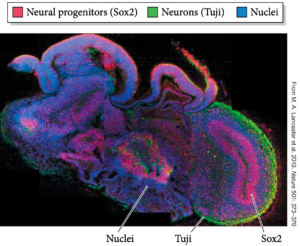
Spring of 2023 Dr. Barresi’s seminar course “Topics in Developmental Biology” was focused on the new technology of organoid systems. Once derived from a monoculture of pluripotent stem cells (ESCs or IPSCs), Organoids are 3D multicellular structures differentiating towards organ-specific tissues and offer the opportunity to study organogenesis in a plate. Organoid systems are particularly exciting because they can be derived from human cells, which means being able to study the development of human organs for the first time.
The students of this BIO323 course created “Docudevelopments” or short documentary movies focused on a subtopic and directly related to a particular research study. These docudevelopments are meant to introduce these organoid systems as well as provide a foundation to increase access for others to enjoy the published research and accompanying full web conference (which are also available for viewing from our BioWeb Conferences Page).
As instructor of the course, Michael Barresi is the producer for all of these documentaries and any questions should be directed toward him at mbarresi@smith.edu.
Docudevelopments of Organoid Development
The Embryoid – The making of the first human embryoid to show signs of gastrulation.
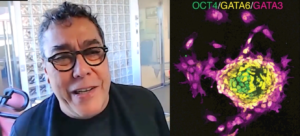
The Ali Brivanlou Lab has cultured human embryonic stem cells into epiblast and extraembryonic tissues and shown that when combined can build an embryoid capable of “breaking symmetry” akin to the first morphogenic movements of gastrulation.
This movie was created by Sana Tayebati and Sam Tower, and is based on the following research paper:
Simunovic M, Siggia ED, Brivanlou AH. In vitro attachment and symmetry breaking of a human embryo model assembled from primed embryonic stem cells. Cell Stem Cell. 2022 Jun 2;29(6):962-972.e4
View the full web conference with Dr. Ali Brivanlou to learn much, much more on the making of human gastruloids.
The Brain Organoid – Investigating how the human brain develops…, …in a plate and in a rat!
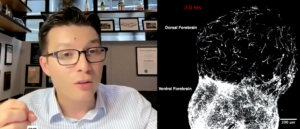
The Sergiu Pasca Lab has perfected the culturing of human induced pluripotent cells into brain organoids. Specifically, they have been able to coax the development of different regions of the early central nervous system from spinal cord to cortex. The Pasca Lab has successfully formed assembloids by combining cortical, spinal cord, and skeletal muscle organoids together to study how neural connections are formed in this human model of neural development. Lastly, they have more recently shown that cortical organoids can thrive even better when put into the brain of a neonatal rat brain, grow larger with more complex neuronal morphologies and form functional circuits with the rat brain capable of controlling behaviors!
This movie was created by Zhixin Liao and Yuqi Wang, and is based on the following research papers:
- Revah, O., Gore, F., Kelley, K.W. et al. Maturation and circuit integration of transplanted human cortical organoids. Nature 610, 319–326 (2022).
- Andersen J, Revah O, Miura Y, Thom N, Amin ND, Kelley KW, Singh M, Chen X, Thete MV, Walczak EM, Vogel H, Fan HC, Paşca SP (2020) Generation of Functional Human 3D Cortico-Motor Assembloids. Cell 183:1913-1929.e26.
View the full web conference with Dr. Sergiu Pasca to learn much, much more on the development of brain organoids.
Brain Evolution Through Comparative Organoid Investigation
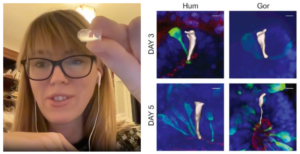
The Madeline Lancaster Lab has been a pioneer in developing methodologies for culturing brain organoids of a variety of species that includes non-human and human primates. By comparing how cortical brain organoids derived from Gorilla and Human IPSCs, the Lancaster lab has discovered a significant difference in the timing of radial glial maturation, which may represent a critically important mechanism for why the human brain is so much bigger. This movie was created by Marie-Jeanne Kabongo and Tania Novosolova, and is based on the following research papers:
- Benito-Kwiecinski, S., Giandomenico, S. L., Sutcliffe, M., Riis, E. S., Freire-Pritchett, P., Kelava, I., Wunderlich, S., Martin, U., Wray, G. A., McDole, K., & Lancaster, M. A. (2021). An early cell shape transition drives evolutionary expansion of the human forebrain. Cell, 184(8), 2084-2102.
- Pellegrini, L., Albecka, A., Mallery, D. L., Kellner, M. J., Paul, D., Carter, A. P., James, L. C., & Lancaster, M. A. (2020). SARS-CoV-2 Infects the Brain Choroid Plexus and Disrupts the Blood-CSF Barrier in Human Brain Organoids. Cell Stem Cell, 27(6), 951-961.
View the full web conference with Dr. Madeline Lancaster to learn much, much more on the evolution of the human brain through organoid analysis.
Ovarian Cancer Organoids – Modeling human ovarian cancer with Fallopian Tube Epithelial Organoids
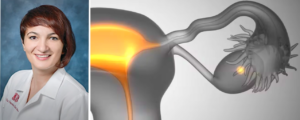
Dr. Nur Yucer in Dr. Clive Svendsen’s Lab has created the first fallopian tube epithelial organoid. Surprisingly, ovarian cancers are derived from tumorigenic epithelial cells of the fallopian tubes. Such a cancer has been impossible to study in humans, which makes targeted therapy development extremely challenging. Dr. Yucer developed the first such system of patient-derived FTE organoids and studied cancer progression following implantation in a mouse. Insight into both disease progression and therapeutic options were revealed. Organoids hold great promise in helping us studying not only human development but also organ-specific disease states.
This movie was created by Stella Alphas and Esme Mexquititla Hernandez, and is based on the following research papers:
- Yucer N, Ahdoot R, Workman MJ, Laperle AH, Recouvreux MS, Kurowski K, Naboulsi DJ, Liang V, Qu Y, Plummer JT, Gayther SA, Orsulic S, Karlan BY, Svendsen CN. Human iPSC-derived fallopian tube organoids with BRCA1 mutation recapitulate early-stage carcinogenesis. Cell Rep. 2021 Dec 28;37(13):110146.
- Yucer N, Holzapfel M, Jenkins Vogel T, Lenaeus L, Ornelas L, Laury A, Sareen D, Barrett R, Karlan BY, Svendsen CN. Directed Differentiation of Human-Induced Pluripotent Stem Cells into Fallopian Tube Epithelium. Sci Rep. 2017 Sep 6;7(1):10741.
View the full web conference with Dr. Nur Yucer to learn much, much more on cancer organoids.